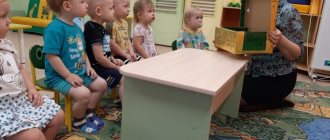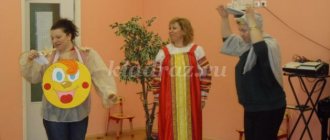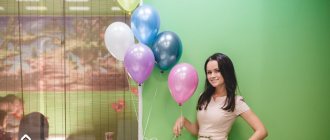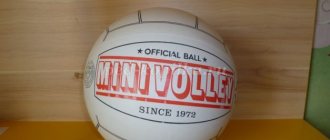The program of the theater group "Fairy Tale" in the middle group
Alfiya Pronina
The program of the theater group "Fairy Tale" in the middle group
Explanatory note
Artistic and aesthetic education occupies one of the leading places in the content of the educational process of a preschool educational institution and is its priority direction. For the aesthetic development of a child’s personality, a variety of artistic activities are of great importance - visual, musical, artistic and speech, etc. An important task of aesthetic education is the formation in children of aesthetic interests, needs, taste, as well as creative abilities. Theatrical activities provide a rich field for the aesthetic development of children, as well as the development of their creative abilities. In this regard, in our group I lead the “Fairy Tale” theater group.
Theater activities are aimed at developing the child’s interests and abilities; contribute to overall development; manifestation of curiosity, desire to learn new things, assimilation of new information and new ways of action, development of associative thinking; perseverance, determination, manifestation of general intelligence, emotions when playing roles. In addition, theatrical activities require the child to be decisive, systematic in work, and hardworking, which contributes to the formation of strong-willed character traits. The child develops the ability to combine images, intuition, ingenuity and ingenuity, and the ability to improvise. Theatrical activities and frequent performances on stage in front of audiences contribute to the realization of the child’s creative powers and spiritual needs, emancipation and increased self-esteem. Alternating the functions of performer and spectator, which the child constantly takes on, helps him demonstrate to his comrades his position, skills, knowledge, and imagination.
Exercises for the development of speech, breathing and voice improve the child’s speech apparatus. Completing game tasks in the images of animals and characters from fairy tales helps to better master your body and understand the plastic possibilities of movements. Theatrical games and performances allow children to immerse themselves in the world of fantasy with great interest and ease, and teach them to notice and evaluate their own and others’ mistakes. Children become more relaxed and sociable; they learn to clearly formulate their thoughts and express them publicly, to feel and understand the world around them more subtly.
Relevance . Using the program allows you to stimulate children's ability to imaginatively and freely perceive the world around them (people, cultural values, nature, which, developing in parallel with traditional rational perception, expands and enriches it. The child begins to feel that logic is not the only way to understand the world, that something that is not always clear and common can also be beautiful. Having realized that there is no one truth for everyone, the child learns to respect other people’s opinions, be tolerant of different points of view, learns to transform the world, using fantasy, imagination, and communication with people around him.
This program describes a training course in theatrical activities for preschool children aged 4-5 years (middle group).
Novelty. The program systematizes the material described in the literature.
Goal: To develop the communicative and creative abilities of children through theatrical activities.
Tasks:
1. Create conditions for the development of creative activity of children participating in theatrical activities.
2. Improve children’s artistic skills in terms of experiencing and
embodiment of the image, as well as their performing skills.
3. To form in children the simplest figurative and expressive skills, to teach
imitate the characteristic movements of fairy-tale animals.
4. Teach children the elements of artistic and figurative means of expression (intonation, facial expressions, pantomime).
5. Activate children’s vocabulary, improve the sound culture of speech, intonation structure, and dialogic speech.
6. To develop experience in social behavior skills and create conditions for the development of children’s creative activity.
7. Introduce children to various types of theater.
8. To develop children's interest in theatrical play activities.
9. Develop a desire to speak in front of parents and kindergarten staff.
The program involves two classes per month in the afternoon - 15:45-16:05. Lesson duration: 20 min.
The activity is carried out in the form of a game:
-Game exercises;
-Sketches;
-Game-dramatization;
-Plot-role-playing game.
Expected Result:
• Revealing children's creative abilities (intonation pronunciation, emotional mood, facial expressiveness, imitation skills).
• Development of psychological processes (thinking, speech, memory, attention, imagination, cognitive processes, fantasies).
• Personal qualities (friendships, partnerships; communication skills; love for animals).
Summing up forms:
-Theatrical performances;
-Leisure;
-Participation in competitions for theatrical activities.
Perspective-thematic plan:
September
1. Theoretical Topic. Introduction to the concept of theater: puppet theater “Repka”, Youth Theater, drama theater (showing slides, paintings, photographs).
Purpose: to give children an idea of the theater; expand knowledge of theater as an art form; introduce types of theaters; cultivate an emotionally positive attitude towards the theater.
2. Theoretical Topic. Introduction to theatrical professions (artist, make-up artist, hairdresser, musician, decorator, costume designer, actor).
Goal: to form children’s ideas about theatrical professions; to intensify interest in theatrical art; Expand words knowledge.
October
1. Practical Topic. Plot-role-playing game "Theater".
Purpose: to introduce the rules of behavior in the theater; arouse interest and desire to play (play the role of “cashier”, “ticketer”, “spectator”); cultivate friendly relationships.
2. Theoretical Topic. Watching the “Repka” puppet theater (together with parents).
Goal: to activate cognitive interest in the theater; develop interest in stage performances; explain to children the expression “spectator culture”; “theater begins with a hanger”; cultivate a love for the theater.
November
1. Theoretical Topic. Acquaintance with the types of theaters (shadow, flannel, table, finger, plane theaters, bibabo puppet theater).
Goal: to introduce children to different types of theaters; deepen interest in theatrical games; enrich your vocabulary.
2. Practical Topic. Rhythmoplasty.
Goal: to develop children’s ability to use gestures; develop motor abilities: agility, flexibility, mobility; learn to move evenly around the site without colliding with each other.
December
1. Practical Topic. Introduction to the finger theater. Mastering the skills of mastering this type of theatrical activity.
Goal: to develop interest in various theatrical activities; continue to introduce children to the finger theater; skills in mastering this type of theatrical activity; develop fine motor skills in combination with speech.
2. Practical Topic. Psycho-gymnastics.
Goal: to encourage children to experiment with their appearance (facial expressions, pantomime, gestures); develop the ability to switch from one image to another; cultivate a desire to help a friend; self-control, self-esteem.
January
1. Practical Topic. Reading the Russian folk tale "Turnip". Work on speech (intonation, expressiveness).
Goal: to develop a sense of rhythm in movements, speed of reaction, coordination of movements; improve motor ability and plastic expressiveness; expand the range due to the sound of the voice.
2. Practical Topic. Re-enactment of the r. n. With. "Turnip".
Goal: create a positive emotional mood; develop a sense of self-confidence; introduce children to the art of theater.
February
1. Practical Topic. Introduction to the concept of “role-playing dialogue”.
Goal: to develop the ability to build dialogues between characters in imaginary circumstances; develop coherent speech; expand the figurative structure of speech; develop confidence.
2. Practical Topic. Speech technique.
Goal: to develop speech breathing and correct articulation; develop diction, learn to build dialogues; cultivate patience and endurance.
March
1. Theoretical Topic. Reading p. n. With. "The Fox and the Crane."
Goal: develop attention, perseverance; stimulate children's emotional perception of fairy tales; foster friendly relationships between children.
Game exercises.
2. Practical Topic. Dramatization of R. n. With. "The Fox and the Crane"
Goal: to create a desire to participate in games - dramatizations; lead children to create an image of a hero using facial expressions, gestures, movements; cultivate friendly relationships.
April
1. Theoretical Topic. Fairy tale "Teremok". Introduction to the characters of the fairy tale, distribution of roles.
Goal: to develop imagination, imagination, memory in children; ability to communicate in the given circumstances; experience the joy of communication.
2. Practical Topic. Rehearsal of the play based on the fairy tale “Teremok”.
Goal: to develop expressiveness of gestures, facial expressions, voice; replenish your vocabulary.
May
1. Practical Topic. Rehearsal of the play based on the fairy tale “Teremok”.
Goal: continue to teach children to listen to fairy tales; develop associative thinking, performing skills, through imitation of the habits of animals, their movements and voice; cultivate a love for animals.
2. Practical Topic. Performance based on the fairy tale “Teremok” (for parents).
Goal: to improve finger theater skills; develop fine motor skills in combination with speech; cultivate artistic qualities.
Bibliography
1. L. V. Artemova “Theatrical games for preschoolers”, Moscow, “Dedication”, 1991.
2. N. Alekseevskaya “Home Theater”, Moscow, “List”, 2000.
3. L. S. Vygotsky “Imagination and creativity in childhood”, Moscow, “Enlightenment”, 1991.
4. Magazines “Preschool education”: No. 1/95, No. 8,9,11/96, No. 2,5,6,7,9,11/98, No. 5,6,10,12/97 ., No. 10,11/99, No. 11/2000, No. 1,2,4/2001.
5. Magazines “Child in kindergarten”: No. 1,2,3,4/2001.
6. Magazine “Secrets of the Puppet Theater”, No. 1/2000.
7. T. N. Karamanenko “Puppet theater for preschoolers”, Moscow, “Enlightenment”, 1982.
8. V. I. Miryasova “Playing at the theater”, Moscow, “Gnome-Press”, 1999.
9. E. Sinitsina “Games for the Holidays”, Moscow, “List”, 1999.
10. L. F. Tikhomirova “Exercises for every day: developing the attention and imagination of preschoolers”, Yaroslavl, “Academy of Development”, 1999.
11. L. M. Shipitsyna “The ABC of Communication”, St. Petersburg, “Childhood-press”, 1998.
12. T. I. Petrova, E. Ya. Sergeeva, E. S. Petrova “Theatrical games in kindergartens Moscow “School press” 2000
13. M. D. Makhaneva “Theatrical classes in kindergarten” Moscow, Creative Center “Sfera”, 2003
Theater club program "Fairy Tale" for children 4-7 years old
Explanatory note
The program was developed on the basis of the partial program of M.D. Makhaneva “Theatrical games in kindergarten, in accordance with the federal state educational standard for preschool education. The program determines the content and organization of theatrical activities for children from 4 to 7 years of age at the municipal autonomous preschool educational institution of combined kindergarten No. 196.
The program provides experience in the social behavior skills of children with disabilities; is aimed at identifying and developing children with actual giftedness, the ability to defend their own opinion, developing the expressive side of speech, will help overcome timidity, self-doubt, shyness, and develop creativity and imagination.
This Program has been developed in accordance with the following regulatory documents:
Law of the Russian Federation dated July 10, 1992 No. 3266-1 “On Education”.
SanPiN2.4.1.2660-10 “Sanitary and epidemiological requirements for the design, content and organization of work in a kindergarten”
The program consists of two parts:
- mandatory
— the part formed by the participants in the educational process.
The mandatory part of the Program provides the necessary and sufficient level of training in theatrical activities.
The part of the Program formed by participants in the educational process reflects:
— age and individual characteristics of children;
— interests and needs of children and their parents.
Psychological and pedagogical work on theatrical activities with pupils in the senior group is built taking into account the age and individual characteristics of the development of preschool children.
The program is designed taking into account the integration of educational areas
1. Musical education - children learn to hear emotional states in music and convey them through movements, gestures, facial expressions, note the varied content of music, which makes it possible to more fully appreciate and understand the character of the hero.
2. Visual activity - children get acquainted with reproductions of paintings that are similar in content to the fairy tale.
3. Speech development - children develop clear, clear diction, work is being done on the development of the articulatory apparatus using tongue twisters, tongue twisters, and nursery rhymes.
4. Familiarization with fiction - children get acquainted with literary works that will form the basis for the upcoming production of the play. .
5. Familiarization with the environment - children get acquainted with the phenomena of social life, objects of the immediate environment, natural phenomena, which will serve as material included in the content of theatrical games and exercises.
6. Rhythm - children learn to convey the image of a hero, his character, and mood through dance movements.
7. Integration with the artistic and aesthetic area of development: drawing, sculpting, appliqué, non-traditional drawing techniques (nitcography, blotography, monotype, diotype, drawing with grits), napkin applique, mosaic, plasticineography, etc. Musical accompaniment of performances and classes, musical games and exercises, listening to musical fairy tales and works, movements to music
8. Integration with the cognitive area of development: construction from large and small construction sets, Legos and paper. Sensory development – motor skills, hearing, speech, smell (for example: magic bag)
9. Integration with the social and communicative area - gaining experience in various kinds of relationships, moral and patriotic education, socialization.
10. Integration with areas - physical development, health: outdoor games, finger and articulation gymnastics, outdoor activities
Goal of the program: development of speech and creative abilities through theatrical art
Tasks:
1. Activate and shape the child’s cognitive interest.
2. Develop diction based on reading tongue twisters and poetry.
3. Train clear pronunciation of consonants at the end of a word.
4. Develop speech breathing and correct articulation.
5. Introduce theatrical terminology and the main types of theatrical art.
6. Develop the ability to coordinate your actions with others.
7. Develop an ear for music, learn to compose sketches based on fairy tales.
8. Learn to improvise, dramatize nursery rhymes, proverbs
1. Features of the implementation of theatrical activities (national - cultural, demographic)
The implementation of theatrical activities, taking into account the specifics of national-cultural, demographic, and other conditions, is aimed at the development and preservation of the child’s individuality, the child’s achievement of a level of psychophysical and social development that ensures successful knowledge of the world of the immediate environment, the development of figurative expressive speech, through various types of children’s theatrical activities.
In the real educational process, the implementation of the content of education is ensured by a developmental environment, the creation of which takes into account the interests and needs of the child, and provides the child with the opportunity to advance in his development.
The developmental environment promotes the emotional well-being of the child, creates a sense of self-confidence and security, provides an influence on the emotional atmosphere of the educational process, through such environmental components as:
- emotionally supportive, i.e. relations between participants in joint life activities;
- emotionally stabilizing, i.e. routine moments that organize the process of a child’s stay in a kindergarten group;
- emotionally tuning, i.e. external setting (color scheme), various types of tetras, props, attributes for various playing positions, theatrical and gaming material.
- Emotionally - activating, i.e. organizing children's employment (theatrical games, classes) (emotionally training, i.e. conducting mental gymnastic exercises with children, developmental trainings (studies, exercises for sound imagination)
In accordance with this, at the preschool level of education, simultaneously with the development of physical, personal, and intellectual qualities, the child’s competence in various types of theatrical play activities and in the sphere of relationships increases.
The basis for the formation of competencies of a preschool child are general abilities: communicative, cognitive, regulatory, creative, speech.
2. Principles and approaches to the formation of the theater club program
The content of the Program corresponds to the basic principles of developmental psychology and preschool pedagogy and is built on the principle of developmental education, the goal of which is the development of the child and ensures the unity of educational, developmental and training goals and objectives.
Basic principles of construction and implementation of the Program:
— combines the principles of scientific validity and practical applicability;
— meets the criteria of completeness, necessity and sufficiency (allows you to solve set goals and objectives only using necessary and sufficient material, to get as close as possible to a reasonable “minimum”);
— ensures the unity of educational, developmental and training goals and objectives of the education process for preschool children, in the process of implementation of which such knowledge, skills and abilities are formed that are directly related to the development of preschool children;
— is built taking into account the principle of integration of educational areas in accordance with the age capabilities and characteristics of students, the specifics and capabilities of educational areas;
— is based on a comprehensive thematic principle of constructing the educational process;
— provides for the solution of program educational tasks in the joint activities of adults and children and the independent activities of children, not only within the framework of direct educational activities, but also during routine moments in accordance with the specifics of preschool education;
— involves building the educational process on age-appropriate forms of work with children, where the main form of work with preschool children and the leading activity for them is theatrical play.
—
I. Mandatory part
1. Model of organization of the educational process
Modular system for organizing classes
1. Module. "What is theater"? Includes games, exercises, creative tasks, research, creation of joint projects with adults, excursions, exhibitions of children's work. Develops children's vocabulary with theatrical terms and develops theatrical etiquette in children. Provides knowledge on the basics of puppeteering
2. Module. "The magical world of emotions." Introduces basic emotions (Izard's Fundamental Emotions).
3. Module “Acting Training” Aimed at training the speech apparatus, various muscle groups, articulation apparatus, diction, intonation.
The structure of the educational process is based on age-appropriate forms of working with children. The main form of work is theater classes in the Skazka theater group. When working with children, predominantly playful, story-based and integrated forms of educational activities are used. The content is based on play studies of a reproductive and improvisational nature.
In practice, various forms of interaction with children are used: mini-games in other classes, dramatizations, games - dramatization, games - performances, etc.
Independent activities of children:
- social and personal development: individual games, joint games, all types of independent activities that involve communication with peers;
- cognitive speech development: children’s independent reading of short poems, independent games based on works of art, independent work in the book corner, in the theater corner, role-playing games, looking at books and pictures; independent coloring of “smart coloring books”, educational board and printed games, games for a walk, dramatization games
- artistic and aesthetic development : providing children with the opportunity to independently draw, sculpt, design (mainly in the afternoon), examine reproductions of paintings, illustrations, play music (singing, dancing), play children's musical instruments (tambourine, drum, bell, etc.) , listen to music, play various types of theater (bibabo, tabletop, puppet theater, flannel theater, etc.)
2.Subject-based educational environment
The equipment in the theater corner is safe, health-saving, aesthetically attractive and educational. Furniture corresponds to the height and age of children, toys provide the maximum developmental effect for a given age.
Organization of a corner for theatrical activities. When placing equipment in a corner, the space of the room, the character and style of its design are taken into account; it naturally fits into the interior and does not cause a feeling of clutter and randomness.
The developmental environment meets sanitary and hygienic requirements and ensures all areas of children’s development.
In the corner for theatrical activities there is a place for director's games with finger, table, stand theater, costumes on mittens.
In the “Ryazheniya” corner there are various types of theater (bibabo, tabletop, etc.)
— props for acting out skits and performances: a set of dolls, screens, costumes, masks, etc.;
— attributes for gaming activities:
theatrical props, makeup, scenery, director's chair, scripts, books, samples of musical works, seats for spectators. Poster, tickets, ticket office, paints, glue, etc.
3. The content of psychological and pedagogical work on mastering the program of the theater club “Fairy Tale”.
The content of the Program includes a set of educational areas that ensure the diversified development of children, taking into account their age and individual characteristics in the main areas - physical, social and personal, cognitive - speech and artistic and aesthetic.
The content corresponds to the basic principles of developmental psychology and preschool pedagogy and is built on the principle of developmental education, the purpose of which is the development of the child and ensures the unity of educational, developmental and training goals and objectives.
The content of psychological and pedagogical work is aimed at developing the speech, cognitive and motor abilities of children, at deepening children’s acquaintance with various types of theatrical art, promoting the development of independence, creativity, intonation expressiveness of speech; development of verbal improvisation, familiarizing children with the simplest techniques of plotting, enhancing children's participation in joint theatrical performances, the ability to construct simple dialogues, and the ability to pronounce the same phrase with different intonations. Children’s educational activities are carried out in the process of organizing various types of children’s activities (play, communication, labor, cognitive-research, productive, musical and artistic, reading), as well as during routine moments, in children’s independent activities and in interaction with the families of the institution’s pupils.
The solution of program problems is carried out in two main organizational models, including:
- joint activities of adults and children (puppet museum, theater classes, theatrical games, matinees and entertainment)
- independent activities of children (theatrical games in everyday life) - mini-games in other classes, theatrical games-performances, children visiting theaters with their parents, mini skits with dolls during the study of the regional component, involving dolls to solve cognitive problems.
The program is implemented in organized, joint and independent forms of activity.
The educational process is built taking into account the population of students, their individual and age characteristics, and the social order of parents.
When organizing the educational process, the unity of educational, developmental and training goals and objectives is ensured, while the solution to the set goals and objectives is achieved, avoiding overload of children, using the necessary and sufficient material, getting as close as possible to a reasonable “minimum”.
Building the educational process on a comprehensive thematic principle, taking into account the integration of educational areas, makes it possible to achieve this goal.
4. Child achievement monitoring system
planned results of the Program implementation
The monitoring system for children’s achievement of the planned results of mastering the Program provides an integrated approach to assessing the final and intermediate results of mastering the Program and allows for assessing the dynamics of achievements.
Monitoring is based on an analysis of children’s achievement of intermediate results, which are described in each section of the program.
The form of monitoring is primarily observation of the child’s activity in classes and in independent activities, analysis of the products of children’s activities and special pedagogical tests organized by a teacher, psychologist, and speech therapist. Data on the monitoring results are entered into a special child development card . Analysis of development maps allows us to evaluate the effectiveness of the program and the organization of the educational process in the Skazka theater group.
Monitoring of program implementation is carried out on the basis of observation and analysis of the products of children's activities. During monitoring, diagnostic cards are filled out.
The content of the monitoring is closely related to the implemented comprehensive General Education program in kindergarten, the “Childhood” program, edited by T.I. Babaeva.
Expected skills and abilities:
- are able to act in a coordinated manner;
- know 5-8 articulation exercises;
- remember given poses and know how to relieve muscle tension;
- remember and describe the appearance of any child;
- are able to take a long breath with an imperceptible short breath, without interrupting the breath in the middle of a phrase;
- can pronounce tongue twisters at different rates and in a whisper;
- are able to expressively read a dialogical poetic text, pronounce words correctly and clearly with the required intonation;
- are able to compose sentences with given words.
- know how to control a doll and improvise with it;
Diagnosis of levels of creative giftedness is carried out on the basis of creative tasks, as well as the diagnostics “Gifted Child”, “Express Questionnaire for Teachers”, observations and tests of a psychologist and speech therapist. An individual development map is drawn up for each child
5. Criteria for assessing the levels of skills for the development of creative and speech abilities through theatrical activities
| High level (3 points) | Intermediate level (2 points) | Low level (1 point) | Total points |
| Fundamentals of theatrical culture | Shows a strong interest in theatrical activities. Knows the rules of behavior in the theater. Names different types of theater and knows their differences. | Interested in theatrical activities. Knows the rules of behavior in the theater. Uses his knowledge in theatrical activities. | Shows no interest in theatrical activities. Knows the rules of behavior in the theater. It is difficult to name the types of theater. |
| Emotional-imaginative development | Creatively applies knowledge about the various emotional states of characters in performances and dramatizations, uses various means of expression (facial expressions, gestures, posture, movements) | Has knowledge of various emotional states and can demonstrate them. Need help with expression. | Distinguishes between emotional states and characteristics, but finds it difficult to demonstrate them through facial expressions, gestures, and movements. |
| Puppeteering skills | Improvises with puppets while working on a play | Uses puppeteering skills | Possesses basic puppeteering skills |
| Fundamentals of collective creative activity | Shows coordination of actions with partners at all stages of work on the performance | Shows coordination of actions with partners in planning collective activities | Does not show initiative, is passive at all stages of work on the performance |
| A culture of speech | Pronounces words clearly and clearly, knows how to regulate volume, correct speech breathing, well-developed auditory attention, speech hearing, skillfully uses intonation means of expressiveness. Monologue and dialogic speech are well developed. The sound aspect of speech, grammatical structure, and vocabulary expansion are improved. They know how to retell literary works in a coherent, consistent manner, and compose fairy tales and stories. | Pronounces words clearly and clearly, tries to regulate the volume when pronouncing words, uses expressive means, developed auditory attention, speech hearing | He does not pronounce words clearly due to incorrect pronunciation of sounds, does not know how to adjust the volume when pronouncing words and phrases, and uses intonation means of expression with the help of a teacher. |




